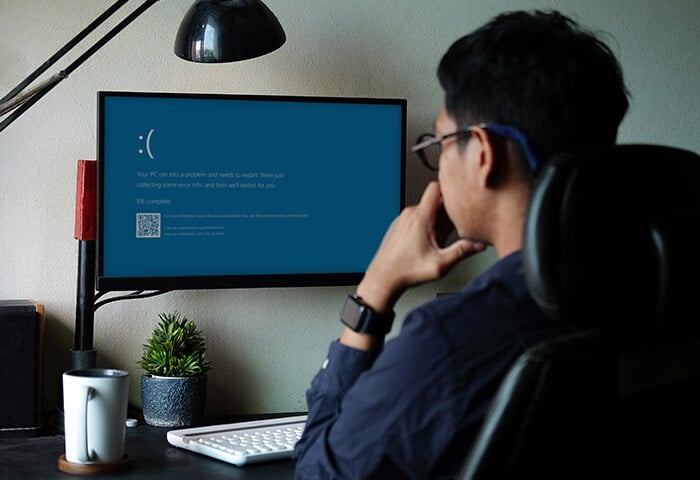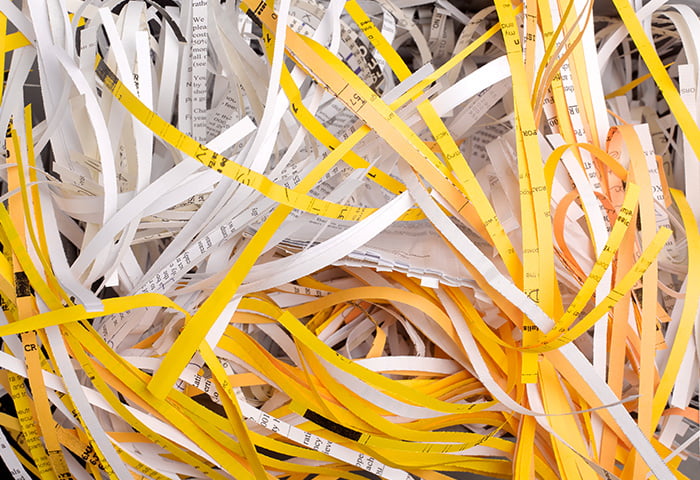How to identify the cause of 100% disk usage in Windows 10 & 11
The best way to identify why your Windows 10 or 11 system is using 100% disk capacity is to use Windows Task Manager. The Windows Task Manager utility shows you exactly what's causing your system to use 100% of your disk capacity — then you'll know which issue you need to fix to lower your disk usage.
If 100% of your disk is being used, it’s likely caused by one of the following issues:
To find out for sure, follow these steps to identify the cause of 100% disk usage with Windows Task Manager:
-
Type Task Manager into the Windows Start menu search field and hit Enter.
-
In the main dashboard, click the Disk column to see all running processes sorted by disk usage.

-
Make sure the arrow in the Disk column is pointing down. That way, you'll see the processes with the highest disk usage first.
Look for items that appear orange and consume more than a few megabytes per second. Any process that takes more than 1 to 2 MB could be a problem. Depending on the type of disk you're using, even a small amount of excess disk usage can harm performance.
17 ways to fix 100% disk usage
Once Task Manager has helped you identify processes causing high disk usage, there are several straightforward ways to try and reduce it. Here, we've outlined 17 methods to fix 100% disk usage on Windows 10 and 11. No matter what's driving up disk usage, the following solutions can help improve system performance and lower disk usage percentages.
To start fixing 100% disk usage issues, scroll down to the individual sections, or click one of these links to jump right there:
-
Update Windows 10 or 11
-
Disable Superfetch
-
Remove viruses and malware
-
Reinstall or update your antivirus software
-
Close background applications
-
Reset or reinstall synchronization tool
-
Rebuild the Windows Search index
-
Repair hard disk issues
-
Delete malfunctioning page files
-
Delete temporary files
-
Update drivers
-
Update hard drive firmware
-
Install and use a new SSD
-
Disable Windows telemetry
-
Turn off Windows tips
-
Optimize visual settings
-
Switch energy options
1. Update Windows 10 or 11
Microsoft often releases Windows 10 and 11 updates that fix bugs and plug security holes. These updates should be installed automatically, but if you've missed the latest release, updating Windows 10 or 11 can fix a variety of issues.
Here’s how to update either version of Windows:
Go to Start > Settings > Update and Security. Then, start the update if one is available. Wait until Windows finishes the installation, and your disk usage should come back down. If you instead see "You're up to date," then you need to figure out what else could be causing Windows 10 or 11 to reach 100% disk usage.

In some cases, 100% disk usage occurs because Windows is updating. During an update, Windows replaces tens of thousands of files, causing the system to slow down, and it may even become unresponsive. If this happens, check the progress by going to Updates and Security, where you'll see that the update is in progress.

If you need to pause automatic updates to prevent disk usage from suddenly spiking, go to Start > Settings > Update & Security > Windows Update. Then click Pause updates for 7 days.
But remember that this can only temporarily lower disk usage, and it's critical to keep your operating system updated to ensure your device is secure and optimized. So start the update again once your overall disk usage is a bit lower.
2. Disable Superfetch
Superfetch, or Service Host Superfetch, is a Windows feature introduced in Vista that analyzes your usage patterns, such as when you launch certain applications and how often. Superfetch then preloads data from those programs into your memory. Usually this works quite well, especially on older hard disks. But it's not perfect.
Some users complain that Superfetch causes constant hard disk usage. Gamers especially seem to hate Superfetch because it tends to preload the files of a game it thinks you want to play, while you're actually playing a different game. Luckily, you don't need Superfetch — and disabling it is just one of the ways to speed up your PC.
If your hard disk is full, and if the following item shows up high on the list in Task Manager, you're dealing with a Superfetch problem.

Disable Superfetch to see if disk usage drops without any decrease in performance — it's trial and error with this one. To disable Superfetch, press the Windows and R keys at the same time and type in services.msc.

Hit OK. You'll see a long list of services that Windows is running. Scroll down until you see SysMain.

Under Startup type, click Disabled and hit OK. Reboot your system and see if performance improves. If not, turn Superfetch back on by completing the same steps — at the end of the process, just select Automatic instead.
3. Remove viruses and malware
Is Task Manager showing you an unknown program with super-high disk usage? It might be that you need to get rid of viruses or malware. In addition to messing with your PC's performance, malware can also steal your personal information, corrupt files or apps, and wreak other havoc.
To help prevent malware infections, learn about the most dangerous current online threats and trends and read our list of the best security and privacy tips.
But there's no substitute for having strong antivirus software. Since malware can play a huge role in pushing Windows 10 or 11 to 100% disk usage, it’s important to install a free antivirus tool. AVG AntiVirus Free not only provides real-time security updates; it also scans your machine to detect malware and performance issues.
4. Reinstall or update your antivirus software
High disk usage can also be caused by antivirus software — during a background scan, or if the tool malfunctions and gets stuck. Go into your antivirus tool's dashboard to see if a scan is in process. If so, do not stop it. Your antivirus may be dealing with a nasty piece of malware.
If the scan seems frozen, reboot your system and let it sit for a while until the antivirus stops. If it doesn't stop, then you might need to reinstall the antivirus, update it, or find another one. AVG AntiVirus Free is a resource-light solution you can try right now.
5. Close background applications
Running lots of applications at once may cause 100% disk usage in Windows 10 and 11. Uninstalling these programs often isn't possible because you may need them. Manually pausing the background apps is only a short-term solution, as many will restart upon bootup or run quietly in the background.
The patented Sleep Mode in AVG TuneUp identifies resource-intensive background applications and deactivates them to free you from 100% disk usage. When you need to use one of the closed apps, AVG reactivates it immediately. Plus, AVG TuneUp identifies unnecessary apps and removes bloatware.
 AVG TuneUp snoozes background apps and startup processes to reduce disk usage.
AVG TuneUp snoozes background apps and startup processes to reduce disk usage.
Try Sleep Mode out for yourself. Download and install AVG TuneUp, then go to Speed Up and click on Background & startup programs. You can also remove junk files and bloatware, optimize your hard disk, and easily perform other PC maintenance with AVG TuneUp.
Disabling startup apps
To help prevent application overload from building up to 100% disk usage again, manually configure your startup apps to limit the number of programs that launch automatically when you fire up your PC.
Here’s how to disable startup apps on Windows 10 and 11:
-
Open Task Manager and click the Startup tab to review which programs run when your computer boots up.
-
Identify and disable any programs you don't need to launch at startup by right-clicking on the program and selecting Disable from the menu.

-
Restart your PC after disabling the apps to apply the changes.
6. Reset or reinstall synchronization tools
Tools like OneDrive or Dropbox take time to synchronize all files. But they can sometimes get stuck and push disk usage to 100% if they're still trying to synchronize after the process is done. This can happen often with large amounts of data.
To fix this, you can reset the programs or reinstall them. For example, you can reset OneDrive by pressing the Windows and R keys at the same time and entering the following command:
%localappdata%\Microsoft\OneDrive\onedrive.exe /reset
After clicking OK, OneDrive will reset and resync your files. This often solves issues with constant disk usage. So check to see if it's your sync tool clogging up your disk, and try a repair install to fix it.
To restart Dropbox, click the Dropbox icon in the system tray, then right-click and select Quit Dropbox. Once that's done, restart Dropbox by opening the Windows Start menu, and then clicking Dropbox to relaunch the program.
7. Rebuild the Windows Search index
The index in Windows Search helps you find files, folders, emails, and even the content of some of those files instantly. To do that, it scans your hard disk and turns it into a super-fast index to give you immediate results.
Unfortunately, the search feature can lose control as it keeps indexing, with no end in sight — all the way up to 100% disk usage.
In such cases, it's best to rebuild the index. Click the Windows Start button and type indexing.

Click Indexing Options. From there, select Advanced and hit the Rebuild button. That completely erases the index, rebuilds it, and should fix errors that were causing 100% disk usage in Windows 10.
8. Repair hard disk issues
A structural or physical defect can also be responsible for 100% disk usage in Windows 10. To check your disk for errors, try AVG's Disk Doctor, another custom built-in feature in AVG TuneUp that can help reduce high disk usage.
To launch Disk Doctor, install AVG TuneUp. Then open it and click the All functions option in the Action Center. Fire up Disk Doctor and run a check for 100 disk usage or errors.

If AVG TuneUp finds an error, it’s fixed automatically. But if Disk Doctor doesn't work, or if it keeps attempting to fix an issue, you might be looking at a defective hard disk. To prevent data loss, get your files off that disk as quickly as possible. Either copy them to an external hard disk or clone your hard drive and replace the drive with a new one.
9. Delete malfunctioning page files
Whenever your PC runs out of free memory (specifically RAM), it uses a "page file" on your hard disk to expand its memory. Let's say you're editing a 10 GB video file, but you only have 8 GB of memory (at least 2 to 3 GB of which are taken up by Windows and your apps). Your PC will use the page file on your disk as expanded memory.
Over time, this page file can become defective and cause unexpected slowdowns and high disk usage. To fix it, delete that page file and create a new one using these steps:
-
Press the Windows and R keys at the same time and type sysdm.cpl.

-
Click OK and go to Advanced > Performance > Settings > Advanced > Change.
-
Uncheck Automatically manage paging file size for all drives.
-
Select No paging file, click Set, and reboot your system.
-
Repeat steps 1 and 2 again, select System managed size, and click Set.
-
Check Automatically manage paging file size for all drives.

Not sure if your PC is using page files? Try checking how much RAM you have, then looking at the size of large files you typically work with to figure it out.
10. Delete temporary files
Deleting temporary files helps free up space and prevent issues. And, in rare cases, bugs with temporary files can cause a Windows process or application to create hundreds or thousands of files and propel your disk usage up to 100%.
The process for deleting temporary files on Windows 10 and 11 is the same:
-
Go to Settings > System > Storage.
-
Click Temporary Files under Storage settings.
-
Check the box for the types of temporary files you want to delete.
-
Click Remove files to delete the selected temporary files.
When choosing the junk files to delete, check boxes for options like Temporary Files, Downloaded Program Files, Temporary Internet Files, and items in the Recycle Bin. Additionally, Windows might suggest you delete files like System Cache, Delivery Optimization Files, and Previous Windows Installations (if applicable).

To regularly clean up temporary files without lifting a finger, download AVG TuneUp and give its disk cleaning functionality a spin. It'll scan your machine for junk files and bloatware, letting you safely delete them and optimize your computer for the best possible performance.
11. Update drivers
Drivers control all the hardware in your computer, including your hard disk controller and the hard drive itself. A bug in an outdated driver could push Windows 10 or 11 to 100% disk usage. See our guides to update your graphics drivers and make sure you have the latest audio drivers.

Make things easier with AVG Driver Updater, which can scan millions of drivers so you don't have to hunt around and update each one. With its easy-to-use interface, you can easily update your outdated or broken drivers, fix your problems, and return your computer to optimal performance. Download it today and try a free scan.
12. Update hard drive firmware
The software inside your HHD hard drive is known as firmware. Recent firmware releases can help fix performance issues or unnecessary read/write operations. You can check if there's an update available.
First, figure out which hard drive you have (if you don't already know). Right-click the Start button and select Device Manager. Expand the Disk drives section and look at the exact names of your drives:

In this example, the main drive is the Samsung SSD 970 EVO Plus. So you'd visit Samsung's support pages to see if there's an update available — and voila! There's new firmware available.

Download the firmware, then restart your computer to see if it fixes your problem with high disk usage.
13. Install and use a new SSD
Installing an SSD could fix a 100% disk usage problem since SSDs are much faster than HDDs. With no moving parts, SSDs reduce access times and boost data throughput, resulting in quicker system bootup, faster program launches, and improved file transfers. However, you still need to ensure you have enough space on your SSD to avoid 100% disk usage.
Already use an SSD? To check if your device's slowness is due to SSD 100% usage, open File Explorer and select This PC. The listed SSD displays its free and used space. You should always keep at least 20% free space on your SSD to maintain optimal performance and avoid 100% SSD disk usage.
14. Disable Windows telemetry
Windows telemetry's primary purpose is to gather diagnostic and usage data from your system and send it to Microsoft. This capability helps optimize Windows features but can cause unnecessary increases in disk usage, and you may not like the idea that Windows is looking over your shoulder.
Here’s how to turn off Windows telemetry:
-
Open Settings and click Privacy.
-
Click the General tab and turn off Send Microsoft info to help make Windows better and improved.
-
Click the Feedback & diagnostics tab and adjust the settings on how much data you want to send.
15. Turn off Windows tips
Sometimes, Windows provides tips to enhance the user experience, but these tips can trigger background processes that increase disk usage. To reduce disk usage, you can turn off Windows tips by following these steps:
-
Open Windows Settings > System > Notifications & actions.
-
Scroll down and uncheck Get tips, tricks, and suggestions as you use Windows.
16. Optimize visual settings
It's not uncommon to see Windows offering a range of captivating visual effects, like animations or shadows. These intriguing features, although nice to look at, can cause disk usage to increase and system overload. Follow these steps below to optimize visual settings on your device and lower disk usage:
-
Press Windows + R together, type sysdm.cpl, and hit Enter.
-
Locate the Advanced tab and click Settings under the Performance section.
-
Select Adjust for best performance and click Apply, then OK.
17. Switch energy options
Windows often includes visual effects like animations and shadows to enhance user experience, but these features can increase disk usage and slow down your system. To optimize visual settings and reduce disk usage, follow these steps:
-
Press and hold the Windows + X keys and select Power options from the menu.
-
Click Additional power settings, and select the High Performance plan from the list of power plans. In some cases, the High Performance plan may have a different name, especially if you’re not the administrator of your PC.
Is high disk usage slowing down my PC?
If high disk usage is slowing down your PC, your PC will feel very sluggish, even when you aren’t using it for anything resource-intensive. For example, if you’re browsing the web or opening a photo stored on your hard disk, but those tasks take five to ten seconds instead of just one, then fixing high disk usage is likely necessary to speed up your computer.
Here are a few examples of when you can assume your hard disk is being used more than usual:
-
Opening a folder (photos or videos) takes too long: If preview thumbnails take a long time to load, and the green bar at the top of Windows Explorer fills up very slowly, you may have a usage problem.
-
Stuttering gameplay: Even if you have a powerful gaming PC, if loading a game or a new level takes noticeably longer, and there are occasional stutters, it may be because of high disk usage. For example, if your game randomly stops for one or two seconds as it's loading new data into its memory, it might be cause your hard disk can't keep up.
-
Buffering while streaming: If your audio or video player is constantly buffering or displaying blurry or interrupted playback that disrupts your online stream, your disk may be full.
-
Audible noises: Old-school mechanical hard disks are still quite noisy and make rattling noises when busy. If that happens, there's disk thrashing going on.
-
General lag: If you notice unusual lags when clicking on items or opening menus and applications, you should reduce your disk usage.
The clearest way to find out that high disk usage is slowing down your PC is to look at Task Manager. Any process that consumes more than a few MB per second for a prolonged period of time is worth looking into, regardless of the performance impact.
For example, on a seven-year-old HP laptop with an old mechanical drive, the maximum read and write speeds are about 40 to 50 MB per second. If a single process takes up 25 to 30 MB, you might see 100% disk usage sooner than you expect.
But even a gaming PC with a super-fast NVME M2 SSD — with transfer speeds of up to 5 GB per second — can fall victim to 100% disk usage.

A computer running Windows 10 or 11 at 100% disk usage is an inefficient computer — and that's where AVG TuneUp can help. By cleaning out unneeded data, removing unwanted programs, and optimizing your PC with our patented, built-in Sleep Mode, AVG TuneUp helps lower the strain on your hard disk and keep your PC running like new.
Does 100% disk usage damage my disk?
If your Windows 10 or 11 disk usage is at 100% for a long period of time, you might see permanent damage. Constant disk usage increases the temperature and thus the chance that your disk will fail.
There's nothing wrong with high percentage disk usage for a few minutes or even an hour. But if your disk is constantly at maximum capacity, and if this persists for several days at a time, performance may unravel.
High disk usage is a problem with an HDD or SSD. Mechanical disks have a physical head that moves across the disk to read and write to it. Sustained 100% usage can lead to mechanical failure. On a modern SSD, the lifespan of individual cells can decrease if you're constantly writing and deleting data.
It's unlikely that you'll experience data or hardware loss in the short term, but it's definitely a possibility if high disk usage persists. You should identify the culprit and learn how to fix 100% disk usage as soon as possible.
What percentage should your disk be running at?
Using anywhere between 0 and 100% of your disk is perfectly normal, but being stuck at 100% for prolonged periods can be problematic and lead to hard drive failure. Reaching 100% of disk usage while using a storage-intensive program isn't usually a problem. But if your disk is always at 100% usage, run some optimization actions to lower the usage.
Low memory and high usage
When your computer runs out of RAM, it uses a process called “paging to disk,” where it temporarily transfers data from RAM to a virtual page file on your hard disk to free up space. This is common with 4 GB of RAM or less and can cause high disk usage if insufficient RAM supports your programs.
In such cases, upgrading your RAM can help, but it’s only effective if the issue stems from a RAM shortage, so consider how powerful a computer you really need before upgrading.
What not to do when you have 100% disk usage
There are a lot of tips and tricks out there to fix high disk usage. Some are useful, while others are unhelpful or dangerous.
Here’s a short list of what you shouldn’t do when you have 100% disk usage:
-
Don't disable your antivirus: Turning off your AV can put you at risk. If your antivirus is causing high disk usage, check out our antivirus advice above.
-
Don't disable disk defragmentation or turn it off: If a defragmentation process is going on, Windows will pause it while you're working. Let it do its thing while you're not working, and do not turn it off.
-
Don't disable Windows Update: Windows Update is critical to maintaining your computer’s security and helps fix crucial bugs. While your PC may slow down temporarily while updating, you should always keep your PC updated.
Optimize your hard disk with AVG TuneUp
Hopefully this article has helped you solve 100% disk usage. To help prevent it from happening again, uninstall programs you don't need, clean up files, and make sure background processes don't bog you down.
AVG TuneUp can help you take care of all of that and more. It's an all-in-one tool dedicated to restoring your PC to prime performance — and making 100% disk usage a thing of the past. Try it free today.
































